December 16, 2022: We continue down the flooded Tombigbee River, playing ducklings to a mama duck tugboat for 30 miles.
(continued from Demopolis, MS to Silas, AL (Bobby’s Fish Camp))
I woke in the dark that eventually turned into a dull gray day. It was very foggy out — I couldn’t even see across the river. Huge pieces of debris flowed past us, some with passengers. If we’d gotten ahead of the flood the day before, we were definitely back in now. And it was worse.

Although it’s very difficult to tell in this photo, this is at least one full-sized tree, including its roots, floating past us on the river, not 20 feet away from the dock. The fog was very thick.
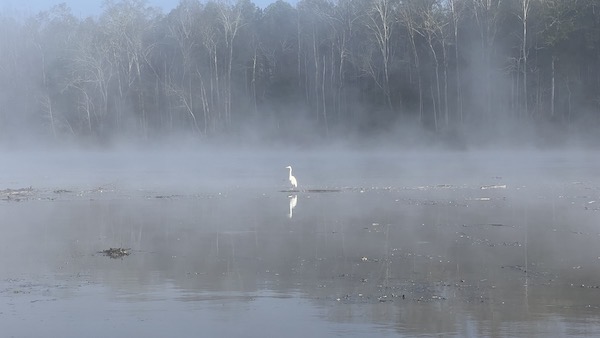
We saw numerous egrets riding down the river on logs.
I was actually surprised that more of it hadn’t hit the boat. I’d heard one or two strikes on the hull overnight but not much more. Perhaps GypSea took the brunt of it? Or maybe it was just far enough off shore to mostly miss us?
AIS showed a tow parked right across the river from us. I couldn’t see it at first, but I did hear its engine. There were two more tows parked about a half mile farther back up the river. I couldn’t see them either. They appeared impossibly close to each other on AIS. The radio had some chatter about whether one tow could spare some lube for the other and how they could get it transferred between the boats. Three tows just upstream of the Coffeeville Lock and Dam with us was bad news. Tows always had priority going through locks.
The good news: this would be the last lock on the Tenn-Tom Waterway. I wouldn’t face another lock until I was deep inside Florida nearly two months later.

Here’s GypSea and Do It Now at the dock at Bobby’s Fish Camp. Once the fog started lifting, it cleared out quickly, giving us a beautiful day. The water levels had come up at least a foot during the night.
Making the Plan
The day got brighter, the fog started to lift and burn off. It looked as if it would be a beautiful, blue sky day — the first I could remember in a long time. We heard from Spencer and Jill in Chasing This at the anchorage. It was foggy there, too. They’d had a good night. They wanted to know when we’d be leaving.
Michael in GypSea made the arrangements. He contacted the lock. They told him that the tows were all going through when the fog lifted a bit. The one right across from us would go first. Then there was a tugboat without a barge that would go and we’d be able to go through the lock with him. The third tow would go last.
That was way better than I expected. We did our morning stuff quickly so we’d be ready to go when we got the signal.
The fog lifted enough to see the tow across the river. He’d come in before we’d turned in for the night and had just parked there. I’m pretty sure that they park by driving the front corner of the tow up into shallow water along the shore. That meant backing up to loosen the tow before heading downstream. As the fog looked serious about lifting, he began to move.
We had to wait for him to pass through the lock and the lock to fill back up before we could get into it, so there was no real hurry. We waited for the unladen tugboat to pass and then Chasing This. When GypSea cast off, we followed them.
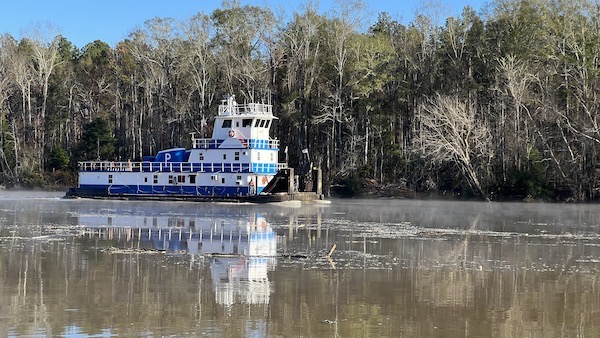
Here’s Cathy Parker, who we’d get to spend a lot of time with that day.
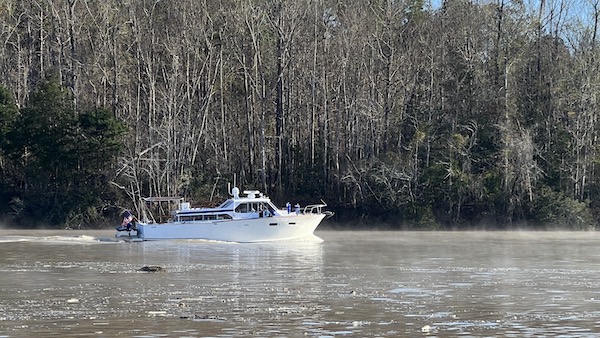
Here’s Chasing This as it headed down the river toward the lock.
The castoff went remarkably well. I had untied and stowed all of the lines except the all important midship line. For that line, I wrapped it around the cleat and handed the end to Alyse with instructions to unfasten it when I gave her the word. There was some question about how to do this — we weren’t right next to the cleat on the dock and the current was keeping the line taut.
“Let it go,” I finally said. “But then bring it in quickly so the loose end doesn’t get into the engine.”
Then I got back to the helm, waited until GypSea was clear, and gave her the word. Idle forward got me moving slowly against the current and I just steered gently into a clear spot between lines of debris. Then I was facing downriver, catching up with the other boats.
It was 9 AM.
The Last Lock
We were all in much better spirits that morning. I guess we all knew that we were halfway — or almost halfway — to Mobile from Demopolis. The worst was behind us, right? Well, not really. But we didn’t know that.
Or maybe it was the weather. That beautiful blue sky!
I used my idle forward trick against the current to position my boat upstream from the lock to wait for it to open. We pretty much stayed put. The tugboat was up against a mooring cell. The other two boats drove around in circles closer to the lock than I was. When the lock gates opened, the tugboat got the call to go in first. He went to the far end of the lock. The other two boats got in with him, one on either side of the lock. I brought up the rear.

Here we are inside the lock. On our side: Cathy Parker, Chasing This, and Us. On the other side: GypSea.
It was a long, slow drop. I took pictures of the other boats and they took pictures of us. I watched a heron (egret?) fishing from a perch on the inside of the gates.

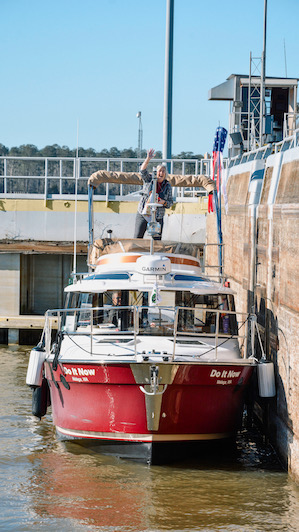
Left: I watched this bird fish from the lock gate as we descended. He actually caught and ate a fish while I was watching. Right: Chasing This sent me this photo of my boat in the lock. I’m up top taking pictures.
Then the gates opened and the boats started pulling out. When it was my turn, I drove right into a roiling hell of turbulence full of churning logs and other debris.
You see, the lock was next to the dam and the dam’s floodgates were open. Tons of water was pouring out. Debris that had managed to get over the dam or through the lock was caught in a swirling eddy right at the exit for the lock. Cathy Parker just pushed its way through. We were trying to avoid hitting any of it.
I should clarify something here. The debris in the river offered multiple hazards. Sure, if I hit a large log hard enough, it could damage my hull. But either my boat or the log needed sufficient speed turned into force for that damage to occur. That’s why I had no problem idling down the day before when I was in the middle of a debris flow: no speed, no force. Idling down prevented a potentially worse problem, though: the possibility of a significantly sized piece of debris hitting a spinning prop (bad) or possibly getting stuck between the prop and rudder (worse). I’d already heard a horror story about this from a boater we’d met at Green Turtle Bay. He’d stirred up some debris in low water at an anchorage and it had gotten stuck between his rudder and prop. The only way to fix it — and the damaged prop — had been to have it towed to a boatyard where it could either be lifted out of the water or inspected by divers. It had cost him thousands of dollars and at least a week of time. This is what was going through my mind when I steered the boat out of the lock and into the swirling, churning, muddy water full sticks and logs.
It was a tough few minutes that made the previous day’s close call seem like a fun little game of dodge logs. This was serious shit, with crazy turbulence and an eddy I didn’t want to be drawn into. Fortunately, the boats in front of me kept moving. I followed them and was soon clear of the worst of it — but back in the same flowing debris we’d been watching all morning and had dodged the previous day.
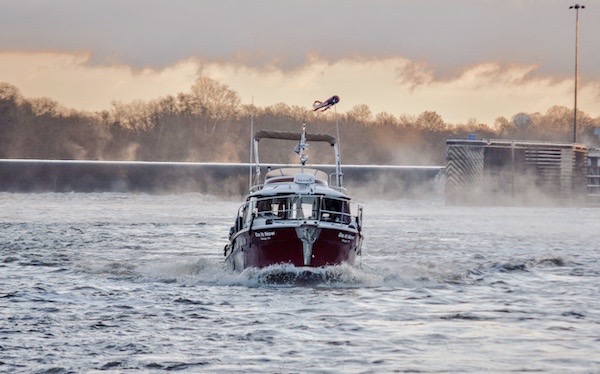
Chasing This sent me this photo of Do It Now coming away from the Coffeeville Lock and Dam. At this point, I was clear of most of the debris.
We pulled into a line behind Cathy Parker to prep for the day’s run. There was no debris right behind the tugboat. And that’s when we realized that Cathy Parker was doing a good 10 to 12 knots. I don’t think any of us had ever seen a tow move so quickly. I know I hadn’t. Even when moving with a good current, they seldom got above 7 knots. But Cathy Parker wasn’t pushing anything. And, as we learned later by eavesdropping on the captain’s conversations with other tows, he was heading to the shop for the boat to get some major required maintenance. While he wasn’t exactly in a hurry, he also didn’t have any reason to be slow about it.
The text messages among the three buddy boats went back and forth quickly. It wasn’t long before we decided to just fall in behind Cathy Parker and follow it as far as we could as long as it continued to keep up a good pace.
So that’s what we did. For 30 miles.
Second Day’s Run
Cathy Parker‘s captain steered a course as if he had a set of big barges tied on in front of him, going wide around the curves and staying in the channels. From my position at the back of the pack, I didn’t once notice him dodging anything. His front end sat kind of low in the water and with a flat bow, his wake basically pushed all the debris aside. Following in his path meant traveling in a mostly cleared area. It was a lot less stressful than the previous day had been.
I still monitored AIS for approaching tows we’d need to pass, but I never made a call until after Cathy Parker did. One time, he made a call to an upbound tow and arranged to pass “on the one” and I almost immediately made a call saying something like, “This is the pleasure craft Do It Now, part of a three-boat group of pleasure craft following Cathy Parker like ducklings. We’d like to pass on the one, also.” I don’t know if they thought it was funny or not. I wondered if other boats ever did what we did.

I shot this photo through my boat’s windshield as we approached an upbound tow. Chasing This drove crazy close to Cathy Parker sometimes.
The captain in Cathy Parker did not communicate with us directly — at least not for that first 30 or so miles. He never even mentioned to other captains that we were right behind him. He had deep voice with a southern drawl. I imagined a big guy — maybe a black guy? — with years of experience as a tow captain. I imagined him enjoying a long, fast run without a bunch of barges to push. I imagined him hoping that three idiot captains in pleasure craft didn’t do something dumber than they were already doing: traveling down the Tombigbee River at flood stage.
And the river was nearly at flood stage. I’d found a website to monitor water levels so I knew how conditions stacked up against “normal.” What I found was that we were in the “action” stage with water levels predicted to climb at least another eight feet over the coming three days. It would technically reach flood stage two days later. Steve at Demopolis had been right about one thing: the river would be dangerous for about five days. But he’d been wrong about the start of the serious danger; we were on the leading edge of it.


Two screen grabs of the flood info for the Tombigbee River at Coffeeville Dam. We were there around the time of the screenshot on the left; the water had risen several feet two days later on the right.
If you don’t understand why this is important, it has to do with the water’s ability to take fallen logs, trees, and other debris off the shore and bring it into the river. The higher the water is and the faster it moves, the more junk it can drag off the shore. We were seeing the junk that had accumulated only a few feet above the normal water line; in the days to come the river would be able to reach higher and drag more junk in. If it got into people’s backyards, we could start seeing all kinds of crap.
But again, we were on the leading edge. Yes, the floodwaters had brought in a lot of debris. But the forecast and then actual flow data proved that it could and would get a lot worse. It we hadn’t left Demopolis when we did, Steve was right: we would have to wait at least five days. While I’m not trying to say we made the right decision. It looked like we could have made a worse one by waiting just a day.
Leaving Cathy Parker
It was early afternoon when we realized that if we didn’t move more quickly than we were behind Cathy Parker we wouldn’t make it to our anchorage by sunset. So after about 25 miles behind the boat, we started texting back and forth about passing.
GypSea was still having the engine cooling issues it had the day before. I knew this because every once in a while, someone would come out onto the boat’s aft deck and look into the water where the water from the cooling system came out. The problem was related to a clog somewhere in the system that they could not reach and less water was getting through than should. I assumed they could see the water coming out, which is why they kept looking back there. Would they be able to go any faster? I didn’t know.
The texts went back and forth for miles. We definitely wanted to pass. But where?
Finally, I took matters into my own hands. I made the radio call telling Cathy Parker we were passing on the two. The river had a wide bend there and the channel hugged the downbound right side of the river. The channel was wide enough to pass, but the river beyond the channel markers on the downbound left side was also plenty wide. With the river several feet above normal levels, I knew that being out there would not put me into shallow water. So I pushed the throttle forward, slipped out of the channel, and passed in nice, smooth, debris-free water.
Chasing This and GypSea apparently did not want to leave the channel at all. And apparently they didn’t want to push their engines very hard. They came out next to Cathy Parker to make the pass, bouncing over its wake and dodging whatever debris it pushed aside. While I was zipping forward at 14+ knots, they were moving along at maybe 12 — just a bit faster than Cathy Parker was doing.
And that’s when Cathy Parker‘s captain decided to talk to us. I think he was put off by my departure from the channel and speed. I think he thought I was being reckless. He warned us about hitting logs and other debris. He made it sound almost as if he wished we’d stick with him so he could protect us.
Almost. Who knows? Maybe I’m reading more into that radio call than there was.
Up ahead, well clear of Cathy Parker, I re-entered the channel and slowed down so the others could catch up. And then I took the lead, forging a path down the channels and around debris just as GypSea had done the day before.
Getting to Our Anchorage
Maybe 10 miles after leaving Cathy Parker — either GypSea or Chasing This took the lead again. I honestly think they didn’t trust me to find a safe path through the debris. I think my departure from the channel had scared the crap out of them — although not once did my depth finder indicate less than 10 feet. (Look at the charts, guys! If it says 6 feet and there’s 2 to 4 feet of floodwater, it’s going to be deeper than charted.) I was not offended — I was actually relieved. I did not want to be responsible for anyone else’s boat. I continued doing the radio communications with tows that we encountered, calling them long before either of the other boats could see them around bends.
Along the way, the debris lessened. I think that once again we’d gotten ahead of the worst of the floodwaters.
The river twisted and turned even more than it had the day before. The sun began sinking to the southwest. The Alabama River joined the Tombigbee River on the east side. Our anchorage was just up ahead, where the Tensaw River joined the Tombigbee.
On AIS, I saw a tow coming up the river, just beyond two bends. It wasn’t clear whether we’d all meet at the confluence at the same time. If we did, it could get messy I made my call, telling him where we were and where we were going. He sounded nervous when he acknowledged. I think he realized that with the swift current, river bends, and his load we’d all have to know what we were doing. Fortunately, we all ducked into the Tensaw River before he came into view. I radioed to him that we were clear up the Tensaw and no longer a factor. And then — for the first time ever — the tow captain thanked me for using AIS and making radio calls to alert them to our presence. He said that it was never good to come around a bend and see a pleasure craft that wasn’t on AIS and hadn’t been talking to them. Knowing we were out there helped make everything safer.
Well, yeah. That’s what the radios were for, right? (And yet another reason I want AIS transmit on my boat — so they can see me.)
Anchoring in the Tensaw
We headed up the Tensaw River toward the anchor marker on Aqua Map. It was about a mile in. The river was a bit narrower than the Tombigbee and perfectly smooth. No debris at all. I got to where I wanted to stop and, with the boat still pointed in the direction I thought was upstream, asked Alyse to go up on the bow, drop the anchor, and play out all the chain. She did. The anchor hit the muddy bottom and immediately grabbed it. And, to my surprise, the boat swung around 180° to point back up the way we’d come.
Apparently the Tensaw didn’t flow into the Tombigbee. Instead, the Tombigbee flowed into the Tensaw?
The other two boats dropped anchor along the river. Chasing This was behind me while GypSea was up ahead, close to a spot where they might be able to land a dinghy on shore. (Did I mention that they had a rather large dog with them?) They actually tried a few spots before settling on one of them. None of them were close enough to me to hear anything from their boats.
The anchorage was calm and peaceful — except for some gunfire in the woods that was probably hunters. Alyse and I settled down to make dinner and relax for the evening.
My pups were not happy to see the green mat on the tray where I expected them to do their business that night.
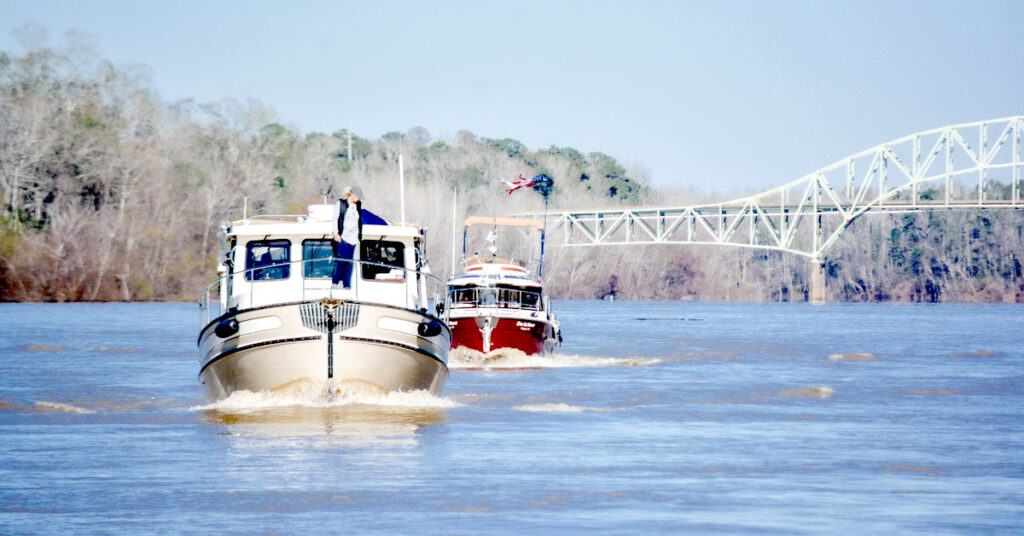
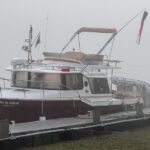

Another nice write-up Maria. Almost feels like we’re sitting there by the helm with you. And I have to say, Gypsea is a nice looking trawler. I’d miss the stern cockpit, but you can’t have it all..
Thanks so much. I really appreciate the comments here. It encourages me to keep writing. I can’t believe how far behind I am!
I have to say that just about all the Looper boats I’ve seen and traveled with so far have been pretty nice. Mine is among the smallest, but it’s also probably the newest.
You plow into a big enough submerged log and you could take out engines, tranny, props and their shafts and get towed to a marina where they want about $75k to fix it. For some, loss of just one engine ends their loop adventure. The waterway was developed to shorten barge trips. His props will chop through most anything. Ever seen one out of the water? He knows what he’s doing. I just watched a YT channel I follow take out his port side everything, even breaking engine mounts. The rivers are hazardous to small boats at any speed, but trying to race is ill advised for another 2knots. Good luck
Like your friend TDW, I am enjoying these updates.
Thanks so much. I’ll try to do another one tomorrow morning. I’m just too tired at the end of the day to write. The next one covers our “shortcut.”